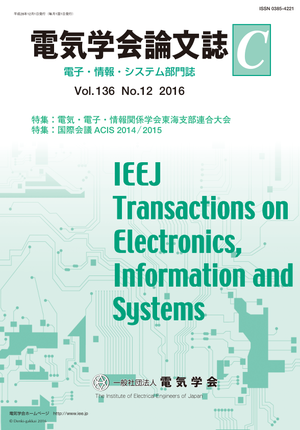頸部冷却刺激に応じた鼻部皮膚温度変動の生体モデルに関する検討
頸部冷却刺激に応じた鼻部皮膚温度変動の生体モデルに関する検討
カテゴリ: 論文誌(論文単位)
グループ名: 【C】電子・情報・システム部門
発行日: 2016/12/01
タイトル(英語): Examination about Biological Models of Nasal Skin Temperature Change Depending on Cooling Stimulation of Neck Part
著者名: 梶原 靖崇(香川大学工学部),浅野 裕俊(香川大学工学部),坂東 靜(青山学院大学理工学部),野村 収作(長岡技術科学大学工学部経営情報系経営システム工学講座),水野 統太(電気通信大学大学院情報理工学研究科総合情報学専攻),野澤 昭雄(青山学院大学理工学部)
著者名(英語): Yasutaka Kajiwara (Faculty of Engineering, Kagawa University), Hirotoshi Asano (Faculty of Engineering, Kagawa University), Shizuka Bando (College of Science and Engineering, Aroyama Gakuin University), Shusaku Nomura (Department of Management and Information Systems Science / Management Systems Engineering, Nagaoka University of Technology), Tota Mizuno (Department of Informatics Graduate School of Informatics and Engineering, The University of Electro-Communications), Akio Nozawa (College of Science and Engineering, Aroyama Gakuin University)
キーワード: 生体モデル,システム同定,眠気,鼻部皮膚温度,ITS Biological model,System identification,Drowsiness,Nasal skin temperature,ITS
要約(英語): We have examined methods to effectively restrain driver's drowsiness by controlling their nasal skin temperature. In resent years, the various kind of techniques for detecting the drowsiness recently has been proposed. In reality, however, these techniques have the problem which influences driver's operation because they already has suitable sleepiness. In our previous study, not almost all drivers became drowsy by promoting sympathetic nerve activity with the ambient biofeedback system. However two drivers became drowsy. This suggests the possibility that the control is not working well as for their physiological responses. This paper aims to examine biological models depending on several physiological responses. We applied the voltage with the regularity to a thermoelectric element attached to driver's neck and measured their nasal skin temperatures. In addition, we made models for driver's physiological responses by taking advantage of the technologies for system identification such as box-jenkins model, auto-regressive exogenous model, state-space model, output-error model and recursive exogenous auto-regressive moving average model. We evaluated the validity of these models by using the fitting rates and board diagram, with the result that model suitable for each physiological response was box-jenkins under the condition of 15 dimensions and a maximum of 30 seconds. It can be concluded that biological model suitable for each physiological response can be made.
本誌: 電気学会論文誌C(電子・情報・システム部門誌) Vol.136 No.12 (2016) 特集Ⅰ:電気・電子・情報関係学会東海支部連合大会 特集Ⅱ:国際会議ACIS 2014/2015
本誌掲載ページ: 1785-1790 p
原稿種別: 論文/日本語
電子版へのリンク: https://www.jstage.jst.go.jp/article/ieejeiss/136/12/136_1785/_article/-char/ja/
受取状況を読み込めませんでした


